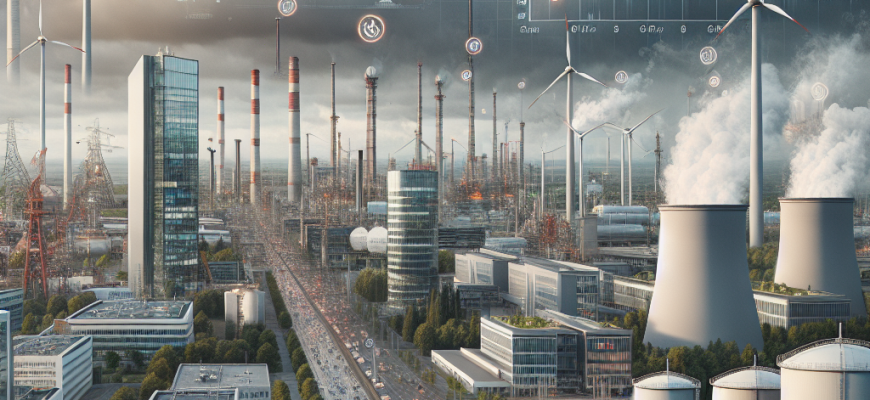- Germany’s Economic Tango: A Slow Dance with Energy Prices
- Greetings, My Friends!
- The Economic Slowdown: A Melancholic Note
- Current Projections
- Historical Context
- The Stinging Buzz of High Energy Prices
- Energy Costs and Productivity
- Consumer Confidence and Inflation
- Structural Challenges: The Good, the Bad, and the Ugly
- Manufacturing Sector and Global Competition
- Skilled-Worker Shortage
- The Government’s Response: A Bold Refrain
- Growth Package and Reforms
- Future Growth Projections
- Sipping from the Sectoral Chalice
- Quarterly GDP Growth
- Investment and Government Spending
- The Grand Finale: A Call to Action
- Key Points to Remember
Germany’s Economic Tango: A Slow Dance with Energy Prices
Greetings, My Friends!
Welcome to the mesmerizing world of Germany's economy, where the dance of growth slows down and the rhythm of high energy prices keeps everyone on their toes. Yes, my dear companions, the once-vibrant powerhouse of Europe is navigating through stormy seas, grappling with challenges that have turned its GDP growth into a cautious waltz rather than a jubilant jive. Buckle up, and let's embark on a curious exploration of Germany's economic landscape and the captivating factors influencing its footsteps.
The Economic Slowdown: A Melancholic Note
Current Projections
As we step into the future, the outlook for Germany's economy casts a shadow. Experts predict a contraction of about 0.2% in 2024—a figure that's as gloomy as a rainy day in Berlin. This projected decline marks the second consecutive year of economic shrinkage, making Germany the sole G7 nation expected to take a step back in 2024. A sobering shift from earlier hopes of a 0.3% growth, this situation raises eyebrows and curiosity alike.
Historical Context
Let's rewind the clock to 2023, when the economy shrank by 0.3%. The unwelcome duo of two consecutive years of decline showcases Germany's first two-year recession since the early 2000s. A bittersweet symphony indeed, resonating through the annals of economic history.
The Stinging Buzz of High Energy Prices
Energy Costs and Productivity
Now, my fellow adventurers, let’s dive into the core of this economic conundrum—high energy prices! Triggered by ongoing geopolitical tensions, particularly the Russia-Ukraine conflict, these spiraling costs have cast a shadow over productivity. As the International Monetary Fund (IMF) rightly states, energy prices are likely to remain stubbornly elevated compared to their pre-war levels, curtailing Germany's economic performance faster than you can say "Wirtschaftswunder."
Consumer Confidence and Inflation
Let’s not forget about inflation, that sneaky little beast that has surged like a rabbit out of a hat, peaking at a staggering 8.3% in June 2022. Although a light at the end of the tunnel suggests moderation to 2.2% in 2024, the effects linger, dampening consumer confidence like a wet blanket. Households are hesitating to open their wallets, casting shadows over economic growth like clouds on a sunny day.
Structural Challenges: The Good, the Bad, and the Ugly
Manufacturing Sector and Global Competition
Now, let us unpack the burdens of structural challenges that weigh heavily upon the German economy. With its steadfast reliance on the manufacturing sector, Germany finds itself squaring off against fierce global competition, particularly from the industrious dragon of the East—China. The need to pivot from fossil fuels to renewable energy, along with the invigorating yet daunting dance of decarbonization and demographic shifts, presents a complex ballet for this European giant.
Skilled-Worker Shortage
And oh, what’s this? A shortage of skilled workers has swept across the nation like an unexpected spell of cold weather, hampering innovation and jeopardizing Germany's competitive edge. It’s a troubling turn of events, one that leaves us pondering the question: how can you stay ahead when the talent pool runs dry?
The Government’s Response: A Bold Refrain
Growth Package and Reforms
In response to this cocktail of challenges, the German government has rolled out a grand growth package comprising 49 measures designed to breathe new life into the economy. This ambitious initiative aims to stimulate investment, enhance productivity, and tackle those pesky, long-standing structural issues. Yet, my friends, the success of this audacious plan hinges on the backing of both houses of parliament—an intriguing political thriller if there ever was one!
Future Growth Projections
Despite the current storm, the government dares to dream of recovery, forecasting a GDP growth rate of 1.1% in 2025, slightly up from a previous estimate of 1.0%. By 2026, the chorus grows even sweeter, with hopes of reaching 1.6%. The magic words: private consumption and stabilizing inflation. Can you feel the anticipation?
Sipping from the Sectoral Chalice
Quarterly GDP Growth
Now, let’s take a peek into the quarters of life in Germany’s economy. In the third quarter of 2024, the GDP inched its way up by a modest 0.1% compared to the previous quarter, bouncing back from a 0.3% contraction. Household consumption grew by 0.3%—a tentative recovery after a 0.5% decline in Q2. And while net trade found its footing in the wrong direction—with exports dropping by 1.9% and imports rising at 0.2%—the narrative is far from straightforward.
Investment and Government Spending
In the realm of investments, the decline softened like a freshly baked loaf of bread, fueled by lesser declines in construction and machinery. Government spending growth, however, took a bit of a chill, slowing down to 0.4% from an earlier pace of 1.6%. A mixed bag of trends, indeed!
The Grand Finale: A Call to Action
As we draw the curtains on this enlightening exploration, we find ourselves in a whirlwind of complexities. Germany’s economic slowdown is a tale of intertwining high energy prices, structural challenges, and global uncertainties. While the government’s growth package and forecasts of potential recovery offer a glimmer of hope, the road ahead remains fraught with challenges, beckoning us to keep our eyes peeled and our spirits high.
Key Points to Remember
- Economic Contraction: Germany’s economy faces a forecasted contraction of 0.2% in 2024, marking a daunting decline.
- High Energy Prices: Elevated energy costs are hampering productivity and lowering potential output.
- Structural Challenges: The reliance on manufacturing, global competition, and demographic shifts pose significant hurdles.
- Government Response: A bold growth package of 49 measures aims to invigorate the economy.
- Future Projections: GDP growth anticipates a revival in 2025 with a rate of 1.1%, increasing to 1.6% by 2026.
- Sectoral Performance: A mix of outcomes in household consumption, fixed investments, and government spending.
Thus, my dear readers, let us keep an eye on this grand economic performance as it unfolds. In the world of finance and growth, every note matters, and every beat can change the melody. Until next time, may your days be filled with curiosity and your minds with insight!









